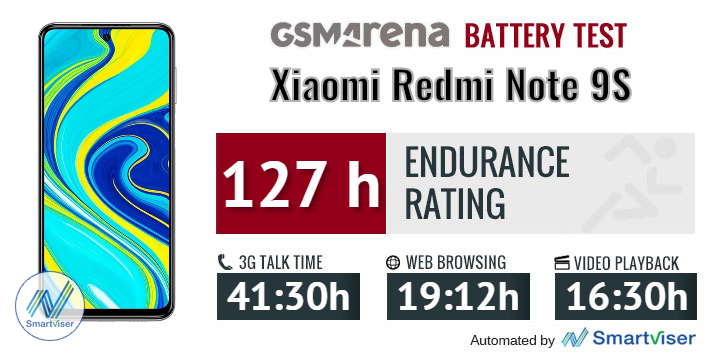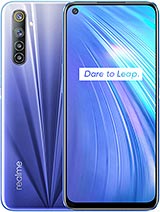Introduction
The popular Redmi Note smartphones are at their ninth generation this year, and the initial limited run has enjoyed a warm reception. But the Note 9 lineup is now going global, spearheaded by the Redmi Note 9S and it's we are about to see what it's made of.
The Redmi Note 9S is a bit difficult to decipher at first, but it is the same phone as the Redmi Note 9 Pro available in India. Maybe we will get the local Pro Max as global Pro later, or maybe we won't.

Anyway, the Redmi Note 9S is shaping as your typical bang for the buck offer - it impresses with glass design, a large screen, a very capable chipset, a good value quad-camera at the back, and a huge battery.
Having reviewed a couple of Realme phones already, we did notice this one glaring omission - a high refresh rate screen - but maybe the Redmi will make up for this in some other way. HRR matters only for the operating system and the default apps as few games (if any) are capable of going beyond 60fps on a mid-range chip anyway.

Let's take a closer look at the specs sheet.
Xiaomi Redmi Note 9S specs
- Body: Plastic frame, Gorilla Glass 5 front and back, splash-proof, 165.8x76.7x8.8 mm, 209g.
- Display: 6.67" IPS LCD, 1080 x 2400px resolution, 20:9 aspect ratio, 395ppi, HDR10.
- Rear camera: Primary: 48MP, f/1.8 aperture, 1/2.0" sensor size, 0.8µm pixel size, PDAF. Ultrawide: 8MP, f/2.2, 1/4", 1.12µm pixels. Macro camera: 5MP, f/2.4, 1.12µm. Depth sensor: 2MP; 2160p@30fps, 1080p@30/60/120fps, 720p@960fps video recording, EIS.
- Front camera: 16MP, f/2.5 aperture, 1.0µm pixels. 1080p/30fps video recording.
- OS: Android 10; MIUI 11.
- Chipset: Snapdragon 720G (8nm): Octa-core (2x2.3 GHz Kryo 465 Gold & 6x1.8 GHz Kryo 465 Silver), Adreno 618 GPU.
- Memory: 4/6GB of RAM; 64/128GB UFS 2.1 storage; dedicated microSD slot.
- Battery: 5,020mAh; 18W fast charging.
- Connectivity: LTE-A; USB-C; Wi-Fi a/b/g/n/ac; dual-band GPS; Bluetooth 5.0; FM radio; IR blaster.
- Misc: Side-mounted fingerprint reader; 3.5mm audio jack.
We like that Xiaomi has started offering splash proofing on its phones, and we are glad to see the audio jack and microSD slot stick around. And with these final thoughts we proceed to pop the Redmi Note 9S box open and see what's inside.
Unboxing the Redmi Note 9S
The Redmi Note 9S retail box contains the usual - a charger, a USB-C cable, and a transparent silicone case.

The Redmi Note 9S supports 18W fast charging, but Xiaomi is shipping it with a 22.5W adapter instead - clearly overqualified for the job.
We saw a similar thing with the Mi 10 phones - the company wants you to have a universal USB-PD charger that's compatible with all sorts of devices and this way - to reduce the charger clutter. We do approve!
Oh, the Redmi Note 9S also comes with a thin screen protector applied in the factory, so that is nice as well.
Special thanks to GearBest for providing the review unit.
Design and handling
This reviewer has been nostalgic for the old dumbphones of various shapes, but today everything is all about the screen, and it usually comes wrapped in glass. And so is the Redmi Note 9S - a Gorilla Glass phone - built around a large screen - and featuring all the trendy curves and flashy paintjobs.

There were times when we were able to recognize a Redmi phone at an instant - by looking at its Android touch keys below the screen. But there is no space for such remnants of the past anymore - the Redmi Note 9S packs one big 6.67" IPS LCD screen of 1080p resolution surrounded by rather thin bezels.

The new display has a punch hole for the 16MP selfies snapper. With this new type of notches, the makers are sacrificing the bare minimum of pixels, and we are happy with this development since the Note 8T. It is not ideal, but it is an improvement.

The earpiece grille is almost invisible above the screen, but contains more than you think - there is also one super tiny white notificaiton LED inside.
Not having an OLED screen makes it nearly impossible for the companies to put the fingerprint scanner under the screen, and that's why it is on the right side of the Redmi Note 9S - that's another recent trend. The surface of the power key is touch-sensitive, and the button also doubles as a fingerprint reader. It is fast and accurate, and we have no complaints.

Moving on to the back of the Note 9S, we are dazzled by the Aurora Blue color on the curved Gorilla Glass 5. Even though we've seen a couple of Aurora Blues on other phones already, this type of paintjob still makes us somewhat dreamy, and we took a break and just looked at the back for a while.

The quad-camera is on the back, and it resides within a small but humping sharp square. Here are the 48MP primary, the 8MP ultrawide, the 5MP macro, and the 2MP depth snappers. The black accent paint goes beyond the camera square downwards towards the LED flash.

Thanks to the centered camera hump, the phone does wobble on a desk, but not as many of the other phones on the market. The Redmi Note 9S wobbles only when you are tapping, using some force at that, around the top part of its screen - something that happens quire rare.
The blue frame is made of plastic and has matte finish unless we count the insignificant polished chamfers. It makes for enough grip, and we felt the Note 9S safe most of the time. Sure, its back is as slippery as it can get, but the frame does a particularly good job balancing that.

Of course, if you are not okay with the grip, you can always use the case that's within the retail box.

The Redmi Note 9S has a lot of nearly extinct features around its sides - an IR blaster on the top, a microSD slot on the left, an audio jack at the bottom.
The Redmi Note 9S is a large phone, and operating it with one hand is not a breeze experience. But that's why it is called a Note in the first place - it is supposed to have a big screen, and expected to pack a huge battery, and if the size bothers you - then you are looking at the wrong phone.

The Note 9S is splash-proof thanks to P2i nano-coating technology, so it will survive the rain and some light splashes. It is not waterproof though, so be careful.
We liked the Redmi Note 9S beautiful design and sleek shape, and we have positive thoughts after using it for a while. It is a well-build phone, eye-catchy, with enough grip, and basic water protection. That's plenty enough.
Display
The Redmi Note 9S features a large 6.67" IPS LCD display with a punch hole notch at the top to make room for the selfie camera. The resolution is extended 1080p - 2,400 x 1,080 pixels - making for a 395ppi density.
The backlighting around the round notch is uneven and it is easily visible on white background. So, be prepared to see this imperfection a lot. Such uneven backlighting is a pretty glaring disadvantage of the LCD panels when compared to OLEDs.
The Redmi Note 9S display is protected with a Gorilla Glass 5, but this Redmi also ships with a screen protector that's been applied in the factory.

The Redmi Note 9S display supports HDR10, and it can display 1080p HDR content from Netflix and the likes thanks to the Widevine L1 DRM support.
Xiaomi promises 1500:1 contrast ratio for the Note 9S screen, and our measurements show it is in the ballpark of the promised value. The maximum brightness is about 420 nits, while the black levels are deep enough at 0.3. The screen can be brighter though if you leave it on Automatic Brightness - it can light up as high as 575 nits in bright ambient light.
The minimum brightness we captured on the white color is 1.1nit - a perfect one for reading sessions in the dark!
| Display test | 100% brightness | ||
| Black, | White, | ||
| 0.303 | 421 | 1389:1 | |
| 0.42 | 575 | 1369:1 | |
| 0.331 | 450 | 1360:1 | |
| 0.453 | 600 | 1325:1 | |
| 0.343 | 451 | 1315:1 | |
| 0.328 | 528 | 1610:1 | |
| 0.318 | 421 | 1324:1 | |
| 0.425 | 461 | 1085:1 | |
| 0.501 | 515 | 1028:1 | |
| 0.399 | 550 | 1378:1 | |
| 0.527 | 714 | 1355:1 | |
| 0.347 | 460 | 1326:1 | |
| 0.486 | 640 | 1317:1 | |
| 0 | 413 | ∞ | |
| 0 | 636 | ∞ | |
Xiaomi offers three different Contrast settings for the Redmi Note 9S display. With the Automatic contrast set to on, the screen output seems to be tuned for accuracy in the sRGB color space, and we measured an average deltaE of 5.9. Only in this mode, you can choose the color saturation (default, warm, cool) and the Delta E of 6.3 was measured with the Default preset. Choosing warm will diminish the noticeable blue tint but won't improve the overall accuracy by much.
The Standard Contrast setting has superb accuracy within the sRGB color space, and we recorded an average deltaE of 2.1 for color accuracy.
Finally, the Increased Contrast makes the colors pop at the expense of reproduction accuracy.
Battery life and charging
The Xiaomi Redmi Note 9S is powered by a large 5,020mAh Li-ion battery. It supports 18W quick charge, but the 9S ships with a 22.5W brick - meaning you will be overequipped. Xiaomi says it is one of their universal chargers for smartphones, smart home accessories, tablets and even small laptops.

The bundled charger refills about 37% of the entirely depleted battery in 30 mins, 60% in 50 mins, while a full charge takes about 1 hour and 45 minutes.
The Redmi Note 9S scored an outstanding endurance rating of 127 hours in our battery life test. The phone shows impressive times across the board - talk time, video playback and web browsing, even standby.

Our battery tests were automated thanks to SmartViser, using its viSerDevice app. The endurance rating above denotes how long a single battery charge will last you if you use the Xiaomi Redmi Note 9S for an hour each of telephony, web browsing, and video playback daily. We've established this usage pattern so that our battery results are comparable across devices in the most common day-to-day tasks. The battery testing procedure is described in detail in case you're interested in the nitty-gritty. You can check out our complete battery test table, where you can see how all of the smartphones we've tested will compare under your own typical use.
Speaker
The Redmi Note 9S has no special treatment for its loudspeaker. It's a single piece, bottom-firing, and tuned mostly for louder mid-tones. It posted a 'Good' result for loudness in our seven-track music test. It lacks a low-frequency thump, but it handles vocals well.
Use the Playback controls to listen to the phone sample recordings (best use headphones). We measure the average loudness of the speakers in LUFS. A lower absolute value means a louder sound. A look at the frequency response chart will tell you how far off the ideal "0db" flat line is the reproduction of the bass, treble, and mid frequencies. You can add more phones to compare how they differ. The scores and ratings are not comparable with our older loudspeaker test. Learn more about how we test here.
MIUI 11 and Android 10
Xiaomi Redmi Note 9S boots the latest version of MIUI 11 out of the box and it runs on top of the latest Android 10 OS.

You can unlock the screen via the side-mounted fingerprint scanner. The reader is easy to set up and works fast. The accuracy is superb, too, and, overall, it is excellent for your daily unlocking.
The Redmi Note 9S supports Dark mode - it will switch all system colors from white to black, and this way, you can save some battery juice on that LCD screen. With MIUI 11 it has been improved, and now more apps support Dark mode, and the icons and their colors have been redesigned to suit it better.






Dark mode
MIUI 11 supports nature alarm and notifications, which sound different depending on the time of the day. Nature sounds have been tailored for alarms and notifications and are far less stressful through the day.




Nature-inspired notifications
There is no app drawer in MIUI, so all your apps are just sitting there on your homescreen, but you can still add them to folders. Some versions of MIUI do include an option to add such drawer, but our global ROM did not have one.
Here are the default home screens on Redmi Note 9S. There's a weather widget in the upper right corner across from a large clock widget. There is a Google pane, the leftmost one.
MIUI 11 has refined looks with less clutter, and you easily spot the Xiaomi efforts towards minimalistic design in the new Settings app.






Lockscreen • Homescreen • Homescreen • Tools • Google Discover • Settings
The task switcher has not changed. It shows all of your recent apps in two columns. Tap and hold on a card for the split-screen shortcut, or just swipe it left or right to close it.





Notifications • Toggles • Recents • Split Screen
Themes are supported on the Redmi Note 9S if that's your thing.




Themes
MIUI also offers a Security app. It can scan your phone for malware, manage your blacklist, manage or restrict your data usage, configure battery behavior, and free up some RAM. It can also manage the permissions of your installed apps and allows you to define the battery behavior of selected apps and applies restrictions only to the apps you choose.
MIUI also offers proprietary Gallery, Music, and Video player. In some regions, the music and video apps include paid streaming options. FM radio app is available, too.
MIUI 11 has a new document viewing app, which supports all popular formats and makes easier viewing docs on your phone.
There is also a new Notes app that now supports Tasks.






Security app • Security app • Gallery • Music • File Manager • Mi Remote
In some markets, the pre-installed applications by Xiaomi will show ads, which is how Xiaomi is compensating for the relatively lowеи prices of its devices. We're reviewing the global version of the Redmi Note 9S, and the only places we noticed ads were the File Manager and the Security apps. Those, while pre-installed MIUI apps, are not essential though and there are ways to get rid of them.
Performance and benchmarks
The Redmi Note 9S employs the Snapdragon 720G chipset, and it is the second phone we meet with this hardware, the first was the Realme 6 Pro. We guess the rivalry is still going strong with these two brands.
The SoC uses an octa-core CPU in a 2+6 configuration - 2x2.3GHz Kryo 465 Gold (Cortex-A76 derivative) cores and 6x1.8GHz Kryo 465 Silver (Cortex-A55 derivative) cores. The GPU in this chip is Adreno 618 - the same one found in the Snapdragon 730.
The Redmi Note 9S is available in two RAM and storage configurations - 4GB/64GB and 6GB/128GB versions.
Finally, the 720G is built on an 8nm manufacturing process - currently one of the most efficient processes available.

We ran a couple of benchmarks, and the CPU is shaping as an excellent performer. The Kirin 810 processor is a bit more powerful, but it's available only in very limited Google-less phones for now.
GeekBench 5.1 (multi-core)
Higher is better
- Huawei P40 Lite
1862 - Xiaomi Redmi Note 9S
1785 - Realme 6
1726 - Xiaomi Redmi K30
1692 - Realme 6 Pro
1666 - Redmi Note 8 Pro
1622 - Realme 6i
1349 - Samsung Galaxy A51
1294
GeekBench 5.1 (single-core)
Higher is better
- Huawei P40 Lite
591 - Xiaomi Redmi Note 9S
570 - Realme 6 Pro
565 - Realme 6
548 - Xiaomi Redmi K30
548 - Redmi Note 8 Pro
493 - Realme 6i
388 - Samsung Galaxy A51
347
In terms of GPU performance, the Redmi Note 9S returns strong numbers for the class, close to its Realme 6 rivals.
GFX 3.1 Manhattan (onscreen)
Higher is better
- Realme 6i
31 - Huawei P40 Lite
30 - Realme 6 Pro
27 - Realme 6
27 - Xiaomi Redmi K30
27 - Xiaomi Redmi Note 9S
26 - Redmi Note 8 Pro
24 - Huawei P30 Lite (perf. mode)
13 - Xiaomi Redmi Note 8T
11 - Samsung Galaxy A51
8.9
GFX 3.1 Car scene (onscreen)
Higher is better
- Huawei P40 Lite
18 - Realme 6i
17 - Realme 6 Pro
16 - Realme 6
16 - Xiaomi Redmi Note 9S
15 - Xiaomi Redmi K30
15 - Redmi Note 8 Pro
14 - Huawei P30 Lite (perf. mode)
6.9 - Xiaomi Redmi Note 8T
5.9 - Samsung Galaxy A51
5.6
Aztek Vulkan High (onscreen)
Higher is better
- Realme 6 Pro
11 - Realme 6
10 - Xiaomi Redmi Note 9S
9.9 - Redmi Note 8 Pro
9.4 - Realme 6i
9.3 - Huawei P40 Lite
8.6 - Samsung Galaxy A51
5.6 - Huawei P30 Lite (perf. mode)
3.4
Throwing all the components into the mix in Antutu, the Redmi Note 9S is somewhat behind the Realme 6, but close to the Snapdragon 720G-powered Realme 6 Pro. Once again, Huawei's Kirin 810 proves superior too.
AnTuTu 8
Higher is better
- Huawei P40 Lite
325777 - Realme 6
288931 - Redmi Note 8 Pro
279355 - Xiaomi Redmi K30
272229 - Realme 6 Pro
268785 - Xiaomi Redmi Note 9S
254000 - Realme 6i
202275 - Samsung Galaxy A51
175363 - Xiaomi Redmi Note 8T
167395
It's obvious the Redmi Note 9S is properly equipped for the class and is consistently scoring great on the tests, no matter their purpose. The heaviest of tasks - gaming - is not only possible on the Note 9S, but a breezy experience.
Your typical quad-camera on the budget
The Redmi Note 9S has one square bump at the back that houses all four cameras. The arrangement is familiar, in fact, it is the same as on the Redmi Note 8T - first is the ultrawide snapper, then the primary one, the depth camera is next, and last is the macro shooter.

The main camera uses a 48 MP sensor with a Quad-Bayer filter, probably the ISOCELL Bright GM2 sensor by Samsung. It's a large sensor with 0.8µm pixels, and the lens has f/1.79 aperture. The image output is 12MP.
The 119-degree ultrawide-angle camera has an 8MP sensor with an f/2.2 aperture. There is automatic distortion correction applied when necessary, but you can opt-out of it.
Then there's the 5MP macro camera with 1.12µm pixels and lens with f/2.4 aperture. Autofocus is available, which is a rarity among those type of snappers and much appreciated.
The last camera on the back is the 2MP depth sensor.
Switching between modes is like in every other camera app - swiping left and right will take you through all modes while tapping in the upper right corner of the screen where the "hamburger menu" resides will expand the options. The Macro mode was hidden within this menu, which is a bit odd.
The real settings menu is in there as well, and it doesn't offer anything out of the ordinary.






Camera app
The Redmi Note 9S offers 48MP mode, as well as manual (Pro) one. Speaking of Pro, this one offers pretty much all the settings you'd need - white balance, focus, ISO, and shutter speed. The Pro mode works with the normal camera, the ultra-wide, and the macro. Manual 48MP pictures are also an option.
Image quality
The 48MP camera saves by default 12MP images, and the ones we shot with the Redmi Note 9S are good for the class. The resolved detail is enough though nothing impressive and that's probably the easiest tell about the budget quality. The foliage is a smudgy mess, the window blinds were too complex for the algorithm and so was any intricate detail.
Still, the photos do offer enough detail, and it gets only better from there - the noise levels are kept low, the contrast is great, and the colors stayed mostly true to life. The dynamic range is pretty wide and the Auto HDR did not fire even once.












Redmi Note 9S 12MP photos
The MIUI 11 camera app has this AI Camera trigger on the viewfinder. This option always uses HDR and oversaturates the colors big time. You will see shadows pop unnaturally, and colors go to extremes. But if you like what you are seeing, then it's there for you to use it.




Redmi Note 9S AI mode
There is a standalone 48MP mode, but what you would does not look like a real 48MP image. The photos seem to be upscaled from the 12MP images and then heavily sharpened. There are no benefits whatsoever when shooting in 48MP, and we don't recommend it.




Redmi Note 9S 48MP photos
The viewfinder offers 2X toggle and the photos are exactly what you would expect - digitally zoomed and lacking in detail.




Redmi Note 9S 12MP 2x photos
The 8MP cam snaps very good ultrawide photos for this budget class with good detail levels, great contrast and rather high dynamic range. The distortion correction does a nice job around the corners and overall - we are happy with this camera.












Redmi Note 9S 8MP ultrawide photos
The 5MP macro camera shoots great closeups. They are detailed, with little noise and quite lively. The autofocus helps a lot in such occasions as opposed to the fixed focus at 4cm most of the competitors are offering. The colors are a bit dull, but other than that - a remarkable job.








Redmi Note 9S 5MP macro photos
The quality of the portraits taken with the rear camera of the Redmi Note 9S depends on the available light as the resolved detail would drastically drop when the light is not good. So, when the right conditions are met - you will be rewarded with some very nice portrait shots - detailed, with good enough subject separation and convincing faux blur.




Redmi Note 9S 12MP portraits
The Redmi Note 9S is a good shooter at night even if the images are underexposed. The detail is rather good, left mostly intact by the noise reduction, while the noise itself is kept in order, too. The color saturation is excellent.
The Auto HDR decided to show its presence on some of the scenes (the hotel building), and its aggressive noise reduction smears a lot of the fine detail, while doing little to develop the underexposed areas or restore some blown highlights. Maybe it's not a good idea to use HDR at night at all.








Redmi Note 9S 12MP low-light photos
You can trigger the AI mode and get a bit more saturated images at sunset, or sunrise, and we liked these. So, you may want to try it, and see if you like the results in low-light.




No HDR • No HDR • AI shot • AI shot
The Night Mode is something you should definitely use. You lose some detail, but the gains are huge - balanced exposure and restored highlights, some detail in the shows pop, too. We recommend this Night Mode - it takes less than 2 seconds, but the results are excellent for this class.








Redmi Note 9S 12MP Night Mode photos
The night photos from the ultrawide-angle camera are barely usable. The are lacking in detail, pretty dark, and the smeared noise everywhere is a big party pooper.
There is no Night Mode for the ultrawide camera, unfortunately.








Redmi Note 9S 8MP low-light ultrawide photos
Here's how the primary camera on the Redmi Note 9S stacks against the rest of the competition in a more controlled environment.



Redmi Note 9S against the Realme 6 Pro and the Redmi Note 8T in our Photo compare tool
Selfies
The 16MP selfies aren't that sharp and we suspect the imager of having a Quad-Bayer filter. Still, the photos are good, HDR works great when needed, and we observed good colors and contrast. We'd be happy with the native 8MP shots though, just saying.




Redmi Note 9S 16MP selfies
The selfie portraits offer competent subject isolation and the background blur is convincing.




Redmi Note 9S 16MP selfie portraits
Video recording
The Xiaomi Redmi Note 9S captures videos up to 4K @ 30fps, but 1080@60fps and 1080@30fps are available as well.
It seems at first that you can capture in these resolutions with all cameras, but you cannot. The ultrawide-angle and macro snappers record only 1080p clips at 30fps.
Let's talk about the main camera. The video bitrate is 40-42Mbps in 4K and about 20Mbps in 1080p at both 30fps and 60fps. Audio is recorded in stereo with a 96Kbps bitrate.
Despite the high bitrate, the 4K videos have average level, but the quality of the video gets a raise with great colors, contrast, and even dynamic range. The noise is almost non-existent, and maybe an overly aggressive noise reduction is to blame for the loss in detail.
The 1080p clips at 30fps are nicely detailed and among the better ones you can get today.
The 60fps, on the other hand, have the same bitrate as the 30fps, and thus their detail is halved, which is then masked by excessive over-sharpening.
We liked the 1080p videos from the ultrawide camera - they are sharp, with good colors and contrast.
Electronic stabilization is available (in settings) only when shooting in 1080p at 30fps and works on the main and ultrawide cameras. The stabilization does a great job smoothing the camera shake at the expense of minor loss of FoV.
Once you are done with the real-life scenarios, take a look at our video compare tool to see how it competes against other phones.



2160p: Redmi Note 9S against the Realme 6 Pro and the Redmi Note 8T in our Video compare tool
Wrap-up
The Redmi Note 9S (or Redmi Note 9 Pro, if you prefer, because the two are identical) is an excellent smartphone and there is no doubt about that at the end of our review. It offers great performance, a large screen, and a good variety of cameras and shooting modes. And typical for the Redmi Notes, this one also excels in battery life.

The Note 9S costs just €229 in Europe, while its 128GB model is sold for €269. And these will surely seal the deal for many, especially if you are a fan of MIUI. But before you hit the Buy button, let's see what else is on the market today.
The competition
The Realme 6 and 6 Pro (where available) are what the Redmi Note 9S should be afraid of. The Realme 6 costs exactly €229, but tops the Redmi with a 90Hz display, a 64MP main camera, and much faster charging. If the Realme 6 Pro is available in your region, then for some extra $50 you can add a proper telephoto cam on the back and an extra ultrawide selfie camera within a pill-shaped notch.
Xiaomi does offer high refresh rate screens on the budget as part of the Redmi K30. The Redmi K30 has an even more impressive display than the Realme's, with a 120Hz refresh rate. Other than that - it runs on the Snapdragon 730G chip and has a familiar quad-camera on the back (64/8/2/2). Currently, the Redmi K30 has very limited availability, but if you can find it and it costs just $30 or so on top of the Note 9S, then why not?
If an AMOLED screen is a must, maybe look at the Galaxy A51. It has a large 1080p Super AMOLED, with capable enough Exynos 9611 chip and a similar quad-camera on the back. One UI 2 is quite snappy on this one, too.




Realme 6 Pro • Realme 6 • Xiaomi Redmi K30 • Samsung Galaxy A51
The verdict
The Redmi Note 9S offers more than enough bang for its buck, but we expected nothing less from a Redmi phone anyway. Is it the best within its price bracket? It is debatable. Realme do offer a smoother OS experience with its 90Hz screen on the Realme 6 and this maybe a tipping point.

But the Redmi Note 9S excels in everything it promises it will, and while it cannot show us the smoothest of MIUIs, it surely impresses with HDR10 skills, a meaningful macro camera, and battery autonomy. These are more than enough by our books and the Redmi Note 9S a phone we can easily recommend.
Pros
- Beautiful Gorilla Glass 5 body, splash resistance
- Large and bright LCD screen, HDR10 support
- Remarkable battery life
- Top-notch performance for this class
- Good photo and video quality for the class
- Latest Android and MIUI
Cons
- Realme offers 90Hz display for the same cash
- The uneven backlight around the notch is an eyesore
- The charging speed could have been faster
- No NFC
Special thanks to GearBest for providing the review unit.
tinyurlis.gdv.gdv.htu.nuclck.ruulvis.netshrtco.detny.im
مقالات مشابه
- پنج چیز وز وز سر و صدا که قطعا خود flatmate ارتعاش و نوسان نیز می تواند موجه بود
- شرکت صادرات و واردات کالاهای مختلف از جمله کاشی و سرامیک و ارائه دهنده خدمات ترانزیت و بارگیری دریایی و ریلی و ترخیص کالا برای کشورهای مختلف از جمله روسیه و کشورهای حوزه cis و سایر نقاط جهان - بازرگانی علی قانعی
- مواد شیمیایی بدترین دشمن شماست. پنج راه برای شکست دادن آن
- سامسونگ جزئیات آن دبیت کارت ورود به آمریکا بعد از این تابستان
- مزایای فروشگاه آنلاین تجهیزات پزشکی نسبت به بازار
- آنچه از شما خشمگین Rishi Sunak داده نشده است, و شما یک تخفیف ،
- شرکت صادرات و واردات کالاهای مختلف از جمله کاشی و سرامیک و ارائه دهنده خدمات ترانزیت و بارگیری دریایی و ریلی و ترخیص کالا برای کشورهای مختلف از جمله روسیه و کشورهای حوزه cis و سایر نقاط جهان - بازرگانی علی قانعی
- غیر قانونی با بیحوصلگی حرف زدن در Chequers بعد
- طراحی دکوراسیون داخلی منزل و طراحی داخلی ساختمان هیرادانا
- D Don't Fall for this اسباب بازی Rip-off